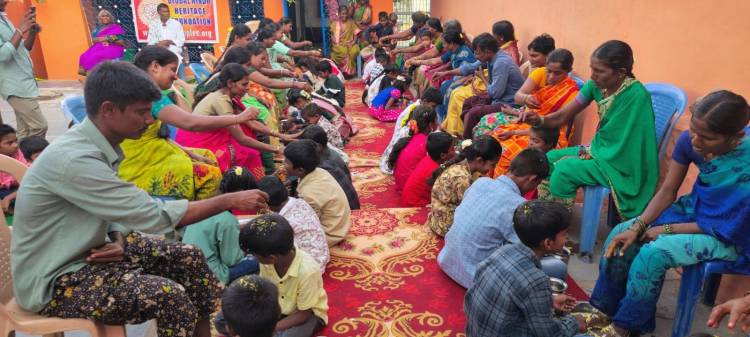[GHHF]Bala Samskar Students Performed Pada Puja to their Parents.
 Understanding Its Significance and Benefits
Understanding Its Significance and Benefits
The Global Hindu Heritage Foundation has been establishing more than 175 Bala Samskar Kendras in nine different States in Bharat. Every month, we made it a point to conduct Pada Puja for the parents of the students attending our classes. Pada Puja is a devotional ritual in Hinduism that involves the ceremonial worship of the feet—most commonly the feet of a spiritual teacher (guru), deity, or elder. The word "Pada" means "feet" in Sanskrit, and "Puja" means "worship" or "adoration." This practice is rooted in the tradition of showing utmost respect, humility, and gratitude toward those considered spiritually elevated or divine.
Why Do Hindus Perform Pada Puja?
Hindus perform Pada Puja for several reasons, all centered around the values of reverence, humility, and spiritual connection:
• Expression of Reverence: The feet are regarded as the most sacred part of a guru or deity, symbolizing their journey and spiritual accomplishments. Touching or worshiping the feet is a gesture of deep respect.
• Symbol of Humility: By bowing to and serving the feet, devotees demonstrate humility and surrender of ego, which are essential qualities for spiritual growth.
• Receiving Blessings: It is believed that the guru or deity's energy and blessings flow through their feet. Pada Puja is a way for devotees to receive these blessings directly.
• Tradition and Ritual: Many Hindu scriptures and stories emphasize the importance of serving and honoring the feet of saints and deities. This ritual is often performed during special occasions, spiritual gatherings, or festivals.
Significance of Pada Puja
The significance of Pada Puja is both symbolic and spiritual:
• Spiritual Connection: Pada Puja helps establish a direct spiritual bond between the devotee and the guru or deity, facilitating the transmission of wisdom and grace.
• Purification: The act of worshiping the feet is considered purifying for the mind and soul, helping devotees shed negative qualities and cultivate virtues.
• Gratitude and Devotion: It is a profound way to express gratitude for the guidance, teachings, and blessings received from the guru or divine being.
• Symbolic Surrender: The ritual signifies surrendering one's ego and personal desires at the feet of the divine, allowing for spiritual transformation.
Benefits of Pada Puja
Devotees believe that performing Pada Puja brings several spiritual and psychological benefits:
• Inner Peace: The act of worship fosters a sense of calmness and tranquility by helping devotees let go of pride and ego.
• Spiritual Progress: Regular practice of Pada Puja is thought to accelerate spiritual growth, as it opens the heart to divine grace and wisdom.
• Blessings and Protection: Devotees seek the blessings of the guru or deity for success, health, and protection from negative influences.
• Cultivation of Virtues: The ritual reinforces qualities like humility, devotion, and gratitude, which are essential for a fulfilling spiritual life.
Pada Puja is a deeply meaningful practice in Hinduism, embodying the values of humility, devotion, and spiritual surrender. Whether performed for a guru, a deity, or an elder, it serves as a powerful reminder of the path to spiritual growth through reverence and selfless service. The ritual not only strengthens the bond between devotee and the divine but also brings numerous psychological and spiritual benefits, making it a cherished tradition within Hindu culture.
Your donations are appreciated.
By Zelle: ghhfusaorg@gmail.com
PayPal: savetemples.org
By Check: Or you can send a check payable to GHHF, 14726 Harmony Lane, Frisco, TX 75035.
It is tax-deductible.
By Rupees: call 601-918-7111






















 Urgent support needed for Bangladesh Hindus
Urgent support needed for Bangladesh Hindus 







